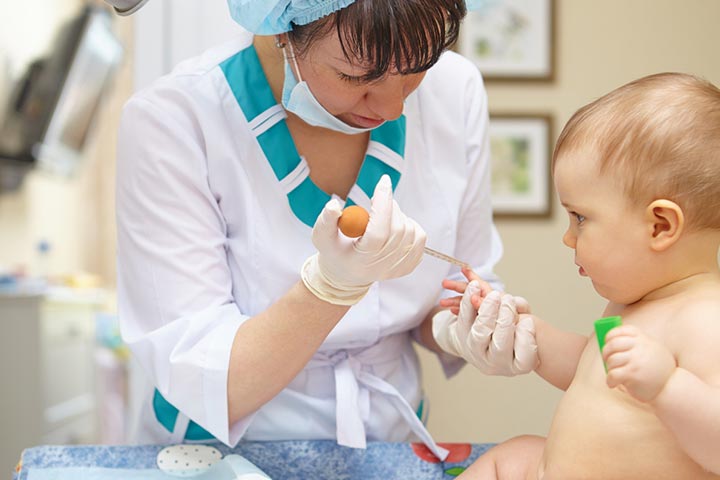Soy is a protein-rich legume capable of triggering allergies in babies (1). It is important to identify the symptoms of soy allergy in babies as early as possible. Soy proteins are treated as pathogens by the immune system of people with soy allergies. It releases antibodies (immunoglobulin E or IgE) to fight the allergen, leading to an allergic reaction (2). Soy should be introduced to babies only when they reach six months of age and above. You may start foods that may be possible allergens in small quantities one at a time. It helps in differentiating between the possible causes of food allergies. Keep reading the post about soy allergy symptoms, causes, and management options in babies for more information.
What Is Soy Allergy?
Soy allergy is the body’s immune response to soy protein, naturally found in soybeans. Soybeans are a common legume used in various products, including baby formula. If a baby is allergic to soy, their immune system misconceives soy protein as a pathogen and releases histamine, causing allergy symptoms, such as coughing, wheezing, and hives. This allergy affects around 0.4% of children in the US, with more cases in babies and young children. Prompt identification of symptoms is essential to avoid adverse allergic reactions, such as anaphylaxis (3) (4).
Symptoms Of Soy Allergy In Babies
A baby allergic to soy can show the following symptoms on the consumption of soy products (5).
- Vomiting
- Dizziness
- Confusion
- Watery eyes
- Stomach cramps
- Indigestion
- Diarrhea
- Wheezing
- Itchiness of the skin
- Hives or rash
- Swelling of the tongue or lips
- Shortness of breath
- Repetitive cough
- Hoarse voice
According to the American College of Allergy, Asthma, and Immunology, a soy allergy can rarely cause an anaphylactic shock, where there is a sudden drop in blood pressure along with difficulty in breathing(5).
When To See A Doctor?
See a doctor or an allergist immediately if the baby shows the following symptoms, which might indicate an anaphylactic reaction.
- The skin turning blue
- Difficulty in breathing
- Drooling or difficulty in swallowing
- Weak or extremely rapid pulse
- The body turning red and warm
Epinephrine (adrenaline) auto-injector can help relieve the conditions immediately. If your baby is confirmed to have a soy allergy, then the doctor may recommend you to keep an epinephrine auto-injector (epipen) handy.
Causes And Risk Factors Of Soy Allergy
It is not very clear as to why some people develop soy allergy. Research suggests that food allergy might be a result of a mix of genetic and environmental factors. Some factors increase the susceptibility to develop soy allergy (6).
- Babies, in general, are more prone to food allergies than adults. According to data from the CDC’s National Center for Health Statistics (NCHS), around 4.4% of children aged between 0 and 5 years in the US have a food allergy.
- The presence of other food allergies and allergic conditions like eczema, asthma, hay fever, etc., increase the risk.
- Infants whose parents or siblings have soy allergy are more likely to have an allergy.
Soy allergy is one of the eight most common food allergies in the US (4). It is a part of the legume family, but a person who has an intolerance to soy need not be allergic to other legumes (5).
Diagnosis And Tests
There is no single method to identify the presence of soy allergy in babies. The doctor might employ the following methods (6).
- Elimination diet test: The doctor will suggest eliminating the suspected food item from the baby’s diet. For instance, if the baby consumes soy-based infant formula, then the doctor may suggest you to replace it with a standard formula. If the symptoms go away with no recurrence, then the doctor can conclude that the baby was allergic to soy. Elimination diet tests could involve multiple trials, thus it might take time to diagnose the allergy. However, this method is safe and non-invasive.
An anonymous mom shares how she used an elimination diet test to identify the specific foods causing allergies in her daughter. She says, “We tried to follow an elimination diet (super difficult with a picky toddler, so we just avoided the Big 7 – dairy, soy, egg, shellfish, peanut, tree nut, and fish – she couldn’t live without wheat…). We were able to determine egg proteins, soy protein, and dairy proteins as her allergens…From vomiting randomly every month or two to more regularly (about weekly) to daily, a diet strictly avoiding dairy, soy, and egg proteins eliminated the GI reactions (i).”
- Blood tests: It will check for the presence of food-specific antibodies in the blood to determine the presence of food allergy.
A skin prick test is performed in older children and adults to determine the presence of food allergies. The test involves injecting a small quantity of suspected allergen into the skin. If a bump develops at the spot of injection, then the allergy is confirmed.
This test may be risky for infants due to the required exposure to an allergen. Also, the bump at the site of injection can be uncomfortable. Therefore, the doctor might use a combination of elimination diet test and blood test to determine the presence of soy allergy in babies.
Treatment Of Soy Allergy
The treatment of soy allergy involves the management of anaphylactic shock and the long-term management of the allergy. The American Academy of Pediatrics enlists the following medicines to help in managing soy allergies in babies (7).
- Epinephrine: It is the first line of treatment. The doctor might suggest and train you on when and how to use the auto-injectable epinephrine for your baby’s allergy. There is no single universal dose of epinephrine. The amount of dosage required by the baby will depend on the intensity of their allergy and body weight. The pediatrician will recommend the exact dose and dosage.
- Antihistamines and corticosteroids: The doctor may suggest these medicines to treat mild cases, which do not require epinephrine.
If it is confirmed that your baby has a soy allergy, then they must avoid the following soy products for the long-term management of soy allergy (8).
- Soy-based infant formula
- Soy flour
- Tofu
- Soy milk and soy milk products, like soy milk yogurt
- Soybean starch and oil
- Cooked soybeans and soybean broth
- Soy sauce and other fermented soy products
The following are some packaged products that might contain soy or soy derivatives.
- Baked items like cookies, crackers, and cakes
- Canned broths and soups
- Cereals
- High-protein energy bars and snacks
- Peanut butter
- Vegetable sauces
- Soaps and moisturizers
It is good to check the ingredients mentioned on the label to determine the presence of soy. Stanford Children’s Health instructs parents to look for labels such as “processed in a facility that also processed soy” or “made on shared equipment” and check with their child’s doctor about the safety of such products. These foods may not contain soy but may have it as a contaminant during manufacturing (9).
Prevention Of Soy Allergy
It is difficult to prevent any food allergy. The following measures might help reduce the risk of soy allergy to a certain extent (10).
- Exclusively breastfeeding or substituting with a hypoallergenic formula is recommended to reduce the risk of soy allergy during the first four to six months of life. Breast milk is known to enhance the immune system and potentially lower the likelihood of developing allergies.
- Begin a solid diet at the age of six months by first introducing the baby to mild food items. Fruits like apples, pears, bananas, or vegetables like sweet potatoes, squash carrots, or rice or oats are good sources of nutrition and may be introduced. Introduce one food item at a time and continue it for three to five days. It helps in identifying if the baby is allergic to any particular item.
- Highly allergic food items like soy, eggs, milk, peanuts, fish, etc., should be introduced only once you know that the baby tolerates mild food items well. It is good to consult a pediatrician before introducing foods that are considered allergic.
- If your baby has an allergy to another food, then consult a doctor before introducing soy. Discuss with the doctor about the quantity of soy that would be safe to introduce.
Soy allergies in babies could show symptoms such as lightheadedness, vomiting, stomach issues, skin changes, breathing difficulties, cough, etc. Thoug














